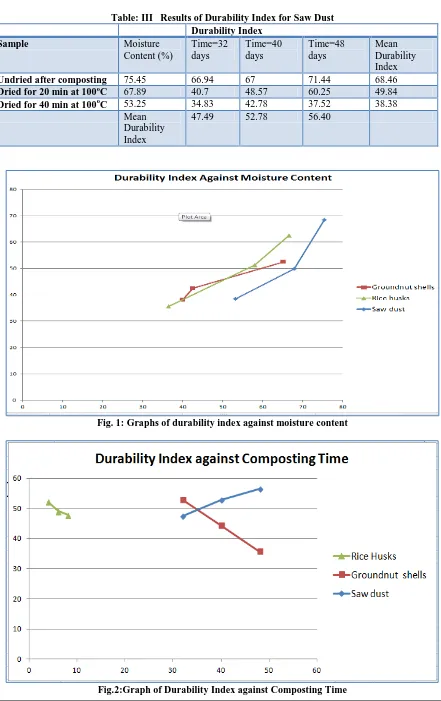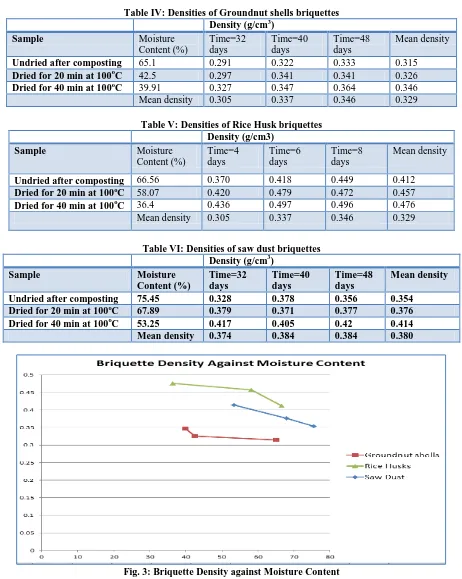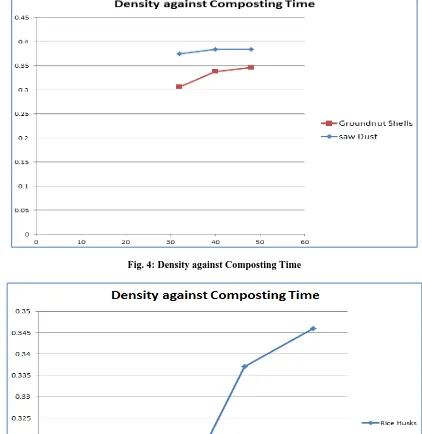e-ISSN: 2278-067X, p-ISSN: 2278-800X, www.ijerd.com
Volume 11, Issue 01 (January 2015), PP.32-38
Effects of Process Parameters on the Density and Durability of
Biomass Briquettes Made from Wet Method
Tito EsauMwinuka
Department of Mechanical and Industrial Engineering, College of Engineering and Technology, University of Dares Salaam, P. O. Box 35131, Dares Salaam, TANZANIA.
Abstract:-This work aimed at improving the density and durability of biomass briquettes made by composting and pressing biomass (wet method). Though this type of briquettes requires much less energy to form, they are usually of much lower density compared to briquettes made from dry biomass. In this experimental work three parameters were considered, which are type of biomass, composting time, and moisture content. Biomass samples were mixed with water and left to decompose for varying number of days. The moisture content of samples was conditioned accordingly and briquettes were made from these samples using a die and a pressing machine. Briquettes were tested for density and durability. Results show that among saw dust, groundnut shells and rice husk briquettes, rice husk briquettes attain highest density (up to 0.47g/cm3). For all three biomass types, durability index tend to increase with an increase in moisture content. Durability of groundnut shells and rice husk briquettes tend to decrease with an increase in composting time while that of saw dust increase with composting time. For all the three biomasses, the apparent density decreases with an increase in moisture content. For groundnut shells and rice husks the density increases with compositing time while for saw dust the change in density is negligible.
In general it can be concluded that better and denser briquettes can be obtained by as long as possible composting time and as low as possible moisture content (but sufficient for bonds formation). However the lower moisture content will decrease durability. Also, saw dust is not recommended for wet briquettes unless long composting time is available. It can be recommended that briquettes which may be subjected to harsh handling and transportation be made using higher moisture content.
Keywords:-biomass briquettes, biomass composting, wet briquetting, briquette density, briquette durability, briquette testing.
I.
INTRODUCTION
Biomass has been the source of energy for many years. Biomass comes from remains of plants and agricultural harvests. Increasing world population and unavailability of other sources of energy for some societies have created a pressure in the forests in search for wood. Unsustainable use of the forests is the main cause of desertification. The main advantage of using biomasses as a source of energy is that they donot increase the net amount of carbon dioxide (CO2) in the atmosphere.Plants absorb CO2 from the atmosphere and release
the same to the atmosphere.Biomass is a source of energy that is highly productive, renewable, carbon-neutral and easy to store and transport. Biomass offers important advantage as a combustion feedstock due to high volatility of the fuel and reactivity of both the fuel and the resulting char. Several efforts have been made to make the use of biomass sustainable which includes the use of biogas and biomass briquettes. Briquettes can be made from many sources including sawdust, coffee husks, rice husks, groundnut shells, sugarcane bagasse and pine needles. Briquettes are made from agricultural and forests waste which otherwise would have to be burnt or just left to rot.Briquettes can find many applications in our societies including domestic cooking as a replacement of fire woods, warming houses in cold regions and uses in furnaces and boilers.
The main objective of this work is to determine process parameters that can improve the density and durability of briquettes from the wet method (composting). Specific objectives are: (i) to identify three suitable biomass, which have a potential of making biomass briquettes from wet method, (ii) To carry out experiments to determine the effect of various process parameters in the density of briquettes, (iii) to recommend suitable process parameters for improving the density and durability of these briquettes and (iv) to investigate which type of biomass briquettes is best in terms of durability and density.
II.
LITERATURE REVIEW
Biomass is a made up of three basic components; lignin, cellulose and hemicellulose. Lignin acts as glue that binds the biomass fibres to give them their natural strength while hemicellulose and cellulose polymers are the basic building blocks of the biomass fibres[3]. The ratio of three components varies from one kind of biomass to another.It is estimated that by 2050 biomass could provide nearly 38% of the world’s direct fuel use and 17% of the world’s electricity [4]. However the availability of fuelwood from forests is continually declining at an ever increasing rate due to indiscriminate deforestation and slow generation as well as afforestation. Currently forest residues, which count for 50% of the total forest products, are left in the forest to rot.
There are several factors that govern compaction of biomass into briquettes. They include design of die, method of load application, loading rate, maximum pressure applied, pressure holding time and material characteristics like particle size and moisture content. Optimal value of humidity is estimated to be 10-18% [5]. For higher humidity excess water turns into steam that tears a briquette to pieces while lower humidity below 10% increases pressure requirement and hence uneconomical. Reference [5] also established that density of briquettes increases with an increase in pressure and an increase in temperature up to 115o. Reference [6] established that biomass species, compacting pressure and particle size have significant effect on the relaxed density and compressive strength of briquettes. To reduce the amount of pressure required for compression, natural decomposition process can be used to breakfibres down and therefore facilitates bonding[7]. Optimum composting time for biomass depends on type and composition. Reference [8] established that while 100% shredded paper briquettes requires about one week soaking, a mixture of shredded leaves and paper required longer time while pure shredded leaves required approximately5 weeks soaking before pressing.Reference [9] found that wet biomass need to be kept on pressing for at least 40 seconds and compaction pressure of not less than 1 MPa to yield quality briquettes. Reference [10] established that the relaxed densities and durability of wet briquetted rice straw, banana leaves and teak leaves increases with increasing pressure from 0.2 to 1 MPa with teak leaves showing highest density of 227.53 kg/m3.
III.
METHODOLOGY
A. Biomass Materials Preparation
Biomass materials, that is, saw dust, rice husks and groundnut shells were collected and the following preparation steps were done. (i) Manually separating unwanted materials from the biomass, (ii) drying the groundnut shells and shredding to reduce particle size, (iii) moisturizing and composting of biomass in plastic bagsand (iv)observing changes on daily basis.
B. Design and Fabrication of a Die and a Tumbler
A triple pelleter/briquetter plunger die assembly was designed. The dimensions were based on the capacity of a press machine such that at least a pressure of 1 MPa could be achieved during biomass compaction. The tumbler is the apparatus used to conduct durability test and was made compliant to ASAE S269.4 standard by taking a rectangular wire mesh box of dimensions 20x20x10cm3 with steel rod of diameter 1cm and length of 50cm hold the box diagonally.
C. Composting, Moisture Conditioning and Briquetting
After composting starts, samples of composted rice husks were taken after 4, 6 and 8 days of composting. Samples of groundnut shells and saw dust were taken after 32, 40 and 48 days. Different composting times were used for rice husks because its rate of decomposition is very high and very easily lead to growth of larvae.Since biomass with different moisture contents are required to make briquettes samples, 3 samples of each type of biomass were put in a drier at 100oC for 20 minutes, 40 minutes and 18 hours respectively. The moisture content of the biomass dried for time t is given by:
[(𝑀𝑤−𝑀𝑓)−(𝑀𝑤−𝑀𝑡)] 𝑥 100
Where: Mw = mass of wet biomass
Mf = mass of dry biomass (after 18 hours drying)
Mt= mass of biomass after drying for time t.
Briquette samples were made from undried, 20 minutes dried and 40 minutes dried biomass for all the 3 biomass materials using a manual hydraulic press machine operating at a pressure of 10 bars and holding time of 7 minutes. The briquetting process was repeated for different composting times. Briquette samples were dried in the sun for 2 weeks before durability and density tests were conducted.
D. Durability Tests
Durability tests give the measure of the briquettes to sustain mechanical handling. This test is done by a standard procedure ASAE S269.4.In order to measure durability, mass of sample is recorded and the sample is tumbled at 63 rpm for 3 minutes in an enclosure of size 200 mm x200 mm x 100 mm. metal cloth of aperture size 6mm2 is used to retain crumbled briquettes after tumbling.
Briquette durability index in percentage is given by, %𝐷𝑖 =𝑀𝑎𝑠𝑠 𝑜𝑓 𝑟𝑒𝑚𝑎𝑖𝑛𝑖𝑛𝑔 𝐵𝑟𝑖𝑞𝑢𝑒𝑡𝑡𝑒
𝑂𝑟𝑖𝑔𝑖𝑛𝑎𝑙 𝑀𝑎𝑠𝑠 𝑜𝑓 𝐵𝑟𝑖𝑞𝑢𝑒𝑡𝑡𝑒 x100%
E. Data Analysis
After durability test of every briquette, Two Way Analysis Of Variance (ANOVA) is performed to see if the variations of obtained results are due to variation of parameter in question, i.e. type of biomass, moisture content and composting time. ANOVA is done with the aid of MINITAB computer software.
IV.
RESULTS AND DISCUSSION
A. Durability Tests
Results for durability tests for different briquette samples of groundnut shells, rice husks and saw dust are shown in Tables I to III. For all the three biomass materials durability is found to increase with an increase in moisture content.According to [1],pressure, heat and solvent such as water are the industrial techniques to promote adhesion by increasing molecular contact between two sets of molecules therefore particle adhesion increase with increasing moisture content. Experimental results shows that for rice husks and groundnut shells briquettes, durability decreases with an increase in composting time however for saw dust briquettes durability tends to increase with composting time up to 48 days.
Table: I Results of Durability Index for Groundnut Shell Durability Index
Sample Moisture
Content (%) Time=32 days Time=40 days Time=48 days Mean Durability Index
Undried after composting 65.1 62.18 55.45 39.76 52.46
Dried for 20 min at 100oC 42.5 53.44 40.13 33.78 42.45
Dried for 40 min at 100oC 39.91 42.9 37.38 33.54 37.94 Mean
Durability Index
52.84 44.32 35.69
Table: II Results of Durability Index for Rice Husks Durability Index
Sample Moisture
Content (%)
Time=4 days
Time=6 days
Time=8 days Mean Durability Index
Undried after composting 66.56 54.86 60.13 72.32 62.44
Dried for 20 min at 100oC 58.07 60.79 49.95 43.03 51.26
Dried for 40 min at 100oC 36.4 40.9 37.44 28.18 35.5 Mean
Durability Index
Table: III Results of Durability Index for Saw Dust Durability Index
Sample Moisture
Content (%)
Time=32 days
Time=40 days
Time=48 days
Mean Durability Index
Undried after composting 75.45 66.94 67 71.44 68.46
Dried for 20 min at 100oC 67.89 40.7 48.57 60.25 49.84
Dried for 40 min at 100oC 53.25 34.83 42.78 37.52 38.38 Mean
Durability Index
47.49 52.78 56.40
Fig. 1: Graphs of durability index against moisture content
B. Density Tests
The densities of the biomass briquettes are measured by measuring their masses and their volumes separately. The volumes determined by measuring the volume of water displaced in a measuring cylinder upon immersing a briquette. The briquettes have to be initially immersed into molten candle wax, allowed to cool before immersion into water. The results of densities are shown in Tables IVtoVI. The results show that for the three biomasses, the densities decrease with an increase in moisture content with rice husks showing the highest mean density of up to 0.497g/cm3 at moisture content of 36.4% and composting time of 6 days. For all three biomasses, densities seem to increase with an increase in composting time. The shape of the graphs however shows that it will reach a point where there will be no further increase in density for increased composting time.
Table IV: Densities of Groundnut shells briquettes Density (g/cm3)
Sample Moisture
Content (%)
Time=32 days
Time=40 days
Time=48 days
Mean density
Undried after composting 65.1 0.291 0.322 0.333 0.315
Dried for 20 min at 100oC 42.5 0.297 0.341 0.341 0.326
Dried for 40 min at 100oC 39.91 0.327 0.347 0.364 0.346
Mean density 0.305 0.337 0.346 0.329
Table V: Densities of Rice Husk briquettes Density (g/cm3)
Sample Moisture
Content (%)
Time=4 days
Time=6 days
Time=8 days
Mean density
Undried after composting 66.56 0.370 0.418 0.449 0.412
Dried for 20 min at 100oC 58.07 0.420 0.479 0.472 0.457
Dried for 40 min at 100oC 36.4 0.436 0.497 0.496 0.476
Mean density 0.305 0.337 0.346 0.329
Table VI: Densities of saw dust briquettes Density (g/cm3)
Sample Moisture
Content (%)
Time=32 days
Time=40 days
Time=48 days
Mean density
Undried after composting 75.45 0.328 0.378 0.356 0.354 Dried for 20 min at 100oC 67.89 0.379 0.371 0.377 0.376 Dried for 40 min at 100oC 53.25 0.417 0.405 0.42 0.414 Mean density 0.374 0.384 0.384 0.380
Fig. 4: Density against Composting Time
Fig. 5: Briquette densities against composting time for Rice Husks
C. Analysis of Variance (ANOVA)
Results of ANOVA for groundnut shells and saw dust conclude that moisture content has got an effect on the mean durability index. Also composting time has got an effect on the mean durability index. For rice husks, on the other hand the results of ANOVA shows that moisture content has an effect on the mean durability index. However composting time does not seem to have significant effect on the mean durability index.
effect on the density of briquettes. However composting time does not seem to have significant effect on the density of briquettes.
V.
CONCLUSION
From the results it can be concluded that saw dust, groundnut shells and rice husk are suitable for making briquettes from wet method given that appropriate composting time and moisture content are given to the biomass. High density briquettes can be obtained by as long as possible composting time and as low as possible moisture content. Durable briquettes are obtained using high moisture content biomass. Except for saw dust, durability seems to decrease with composting time. However for saw dust, these experimental results may not give the true picture as it may need much longer composting times to show its true behaviour, since its decomposition rate is too slow. It seems that parameters that favour higher densities contradict those which favour higher durability. Therefore the compromise has to be reached depending on the environment and how the briquettes are going to be handled.
REFERENCES
[1]. Kaliyan, N and Morey R.V. (2010) Natural Binders and Solid Bidge type binding mechanism in Briquettes and pellets made from corn stover and switchgrass. Bioresource Technology 101 pp. 1082-1090.
[2]. Zhanbin, C. (2003) “Normal Temperature Briquetting Technology for Biomass with Original Moisture Content” Proceedings of International Conference on Bioenergy Utilization and Environment Protection – 6th LAMNET Project Workshop, 24 - 26 September 2003, Dalian, China
[3]. Agbontalor, E. A, (2007) Overview of Various Biomass Energy Conversion Routes, American-Eurasian Journal of Agricultural and Environmental Science Vol. 2 (6), pp. 662-671.
[4]. Demirbas, A. 2004. Combustion Characteristics Of Different Biomass Fuels. Prog Energy CombusSci 30:219–230.
[5]. Krizan, P., Soos, L. and Vukelic, D. (2009), A Study Of Impact Of Technological Parameters On The Briquetting Process. Working and Living Environmental Protection, vol. 6 No. 1, pp 39-47.
[6]. Mitchual, S., Frimpong-Mensah, K. and Darkwa, N. A. (2013) Effect of species, particle size and compacting pressure on relaxed density and compressive strength of fuel briquettes. International journal of Energy and Environmental Engineering 4:30 pp 1-6. http:// www.journal-ijeee.com/content/4/1/30
[7]. Chaney J. O., Clifford M. J. and Wilson, R. (2010),AnExperimental Study Of The Combustion Characteristics Of Low -Density Biomass Briquettes. Biomass magazine 2010, Vol. 1.
[8]. McDougal, O., Eidemiller S. and Weires, N. “Biomass Briquettes: Turning Waste into Energy” Biomagazine.com accessed on November 22, 2014.
[9]. Bikash, B., Bhawmik, R. AND Saikia, M. (2013) Challenges of Wet Briquetting from Locally Available Biomass. International Journal of Modern Engineering Research vol. 3 (3), pp. 1707-1711. [10]. Saikia, M and Baruah, D., 2013, Analysis of Physical Properties of Biomass Briquettes Prepared by


